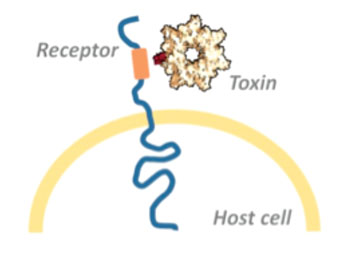Researchers Pinpoint Binding Site for Clostridium difficile Binary Toxin
By LabMedica International staff writers
Posted on 22 Jun 2015
A team of molecular microbiologists has located the site where the bacterium Clostridium difficile's binary toxin binds to intestinal cells' LSR (lipolysis-stimulated lipoprotein receptor) protein and triggers a mechanism that results in the invasion of the host cells by the bacteria.Posted on 22 Jun 2015
Clostridium difficile is a serious intestinal pathogen that can cause severe diarrhea and life-threatening intestinal infections especially after long-term treatment with antibiotics. The bacteria produce the binary, actin ADP-ribosylating toxin CDT (Clostridium difficile transferase). While CDT can lead to death of the host cells through collapse of the actin cytoskeleton, low doses of CDT result in the formation of microtubule-based protrusions on the cell surface that increase the adherence and colonization of C. difficile.

Image: Bacterial toxins usually exert their full deadly effect in the host cell\'s interior. The toxins overcome the cell membrane by binding to a surface receptor, which conveys them into the cell\'s interior (Photo courtesy of Dr. Panagiotis Papatheodorou, University of Freiburg).
Investigators at the University of Freiburg (Germany) examined how CDT binds to its host cell LSR. They reported in the April 16, 2015, online edition of the Journal of Biological Chemistry that CDT interacted with the extracellular, Ig-like domain of LSR with an affinity in the nanomolar range. They identified LSR splice variants in the colon carcinoma cell line HCT116 and disrupted the LSR gene in these cells by applying CRISPR-Cas9 technology.
CRISPRs (clustered regularly interspaced short palindromic repeats) are segments of prokaryotic DNA containing short repetitions of base sequences. Each repetition is followed by short segments of "spacer DNA" from previous exposures to a bacterial virus or plasmid. CRISPRs are found in approximately 40% of sequenced bacteria genomes and 90% of sequenced archaea. CRISPRs are often associated with cas genes that code for proteins related to CRISPRs. The CRISPR/Cas complex comprises a prokaryotic immune system that confers resistance to foreign genetic elements such as plasmids and phages and provides a form of acquired immunity. Since 2013, the CRISPR/Cas system has been used in research for gene editing (adding, disrupting, or changing the sequence of specific genes) and gene regulation. By delivering the Cas9 protein and appropriate guide RNAs into a cell, the organism's genome can be cut at any desired location.
LSR segments created by the CRISPR/Cas technique were expressed ectopically in cells lacking the LSR gene. Results of these experiments showed that intracellular parts of LSR were not essential for plasma membrane targeting of the receptor and cellular uptake of CDT. Furthermore, by generating a series of N- and C-terminal truncations of the binding component of CDT (CDTb), they found that amino acids 757 to 866 of CDTb were sufficient for binding to LSR.
"In the future, it should be possible to block these areas in the toxin and receptor in order to prevent the toxin from entering the host cell," said senior author Dr. Panagiotis Papatheodorou, professor of biology at the University of Freiburg.
Related Links:
University of Freiburg









 Analyzer.jpg)




